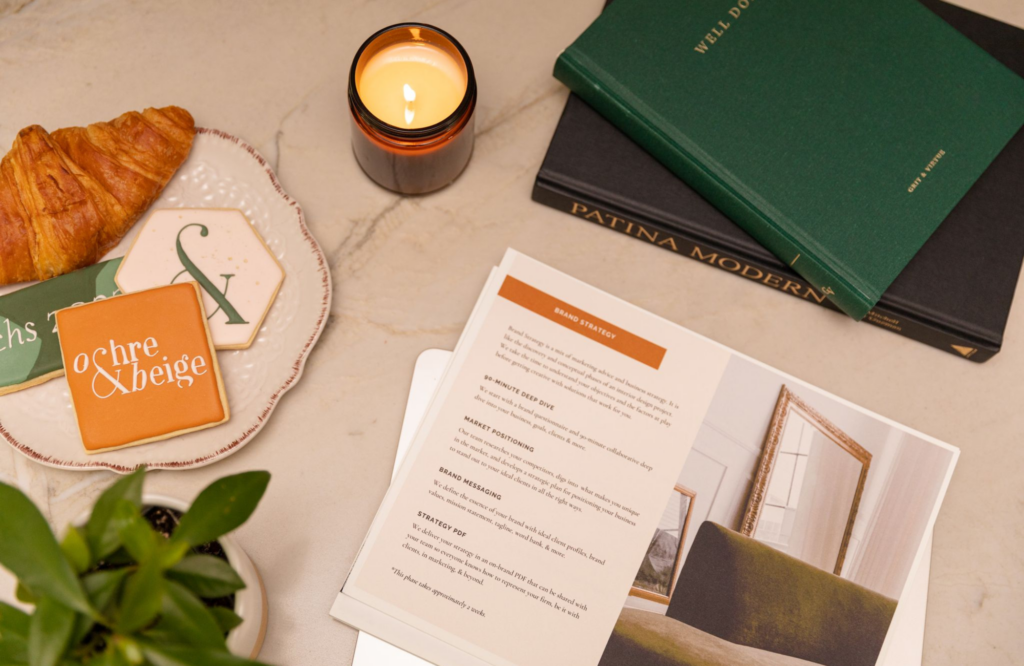The Best Lead Magnet Ideas for Interior Designers

Do you have a lead magnet that is attracting potential clients to your business? Are you using it to build and nurture long-term relationships? If not, you may be missing a huge opportunity.
A lead magnet, also called an “opt-in,” “freebie,” or “complimentary resource,” is an important step in your marketing funnel.
What is it?
In short, it’s a resource that you offer on your website in exchange for someone’s email address — ideally your ideal client’s. Once they’re on your mailing list, you now have the opportunity to develop your relationship with them via a nurture sequence, monthly newsletters, or other outreach.
In fact, we were talking to a prospective client on Zoom the other day and explaining this exact concept and process to her. Suddenly, this look of wonderment crossed her face, and she said, “That was exactly my process of reaching out to you!”
Yep, it works. This month, let’s look at the basics:
- Benefits of a lead magnet as an interior designer
- Most important features of a successful lead magnet
- Our best ideas for lead magnets in the interior design industry
- Where and how you should market your lead magnet
Come take a look…
How Does a Lead Magnet Work?
Logistically, your lead magnet should be delivered automatically by email when someone subscribes to your mailing list. This can be done with any mailing list platform you use (MailChimp, Flodesk, ConvertKit, Active Campaign, etc.).
We personally use and LOVE Flodesk, and you can get 50% off your monthly subscription using our Flodesk affiliate link. Yes, we make a little something if you use this link — and it’s a great deal for you, too!
As far as attaching your lead magnet to the delivery email, if your mailing list platform doesn’t let you attach the PDF directly, we suggest using a publicly shared Google Drive or Dropbox file link.
NOTE: You also have the option to add a sequence of emails — called a nurture sequence — to be delivered in the weeks or months following your lead magnet. We do recommend this, as it creates an intentional experience that nurtures a stranger into someone who loves and trusts your business.

What are the most important features of a lead magnet?
1. Your lead magnet should apply directly to your ideal client.
The best lead magnets make your ideal clients say, “I need that.” If your topic is trendy, it may get a lot of downloads, but it misses the point entirely if those downloads aren’t the people you hope will hire you.
A good example of a lead magnet that doesn’t work well is a “style quiz.” It is impossible to know if someone who downloads (or completes) a style quiz is your ideal client. Compare that to something like a Pre-Renovation Planner. In this case, you know that only people who are genuinely considering renovating will be downloading it. Two very different demographics.
2. Your lead magnet should offer valuable, actionable information.
It is essential that your lead magnet gives your potential clients valuable, useful information — not just inspiration. We are all bombarded with inspiration every day and it rarely leads to action. If you don’t give your potential clients the tools to act, they won’t.
3. Your lead magnet should positively impact their experience with you.
What does that mean? It could involve helping set realistic expectations for their project, helping them better clarify their goals, or making a stronger connection with you. You’ll see several ideas below for lead magnets that can help you do this and pave the way toward a great project together.
4. Your lead magnet should be on-brand.
From the graphic design to its messaging and photography, your lead magnet is an extension of your design studio. Make sure that it feels cohesive with what they see on your website and in person to build trust and connection. Please, please, don’t send a Word Doc. (We recommend designing it in Canva.)
5. Your lead magnet needs a call to action.
The final feature of a successful lead magnet is having a Call to Action at the end. We usually suggest including a short bio of you, along with a button/link that encourages potential clients to take the next logical step with you, such as booking a discovery call. This is also important if your recipient decides to pass along this resource to their friends!
5 of the Best Lead Magnet Ideas for Interior Designers
1. The Pre-Project Planner (for Renovations, New Builds, or Home Furnishing)
As we mentioned above, sharing a project planner is one surefire way to only attract subscribers you know are interested in this type of project. Based on the services you offer, this could look like a variation of any of these topics:
- The Pre-Renovation Guidebook
- A Complete Guide to Furnishing Your New Home
- Most Important Steps Before Building a Custom Home
In each of these, we recommend including your own advice for the biggest aspects of a home project: goal-setting, understanding timeline, estimating the investment, and hiring the experts.
2. The Furnishings Investment Guide
The pros of this resource topic is that incoming clients will have better expectations for what items, like that custom sofa they have their eye on, really cost. The downside of this topic is that it puts the emphasis on money, which may speak less to the luxury design client and more to the financially-conscious client.
If you do decide to pursue this resource, you could include:
- An intro to the differences between retail, showroom, and custom products
- Tips for mixing and matching price points to build the best investment plan
- A room-by-room breakdown of furnishings with high-quality vs. luxury or custom price points
- Be sure to mention that these rates do not include design fess, shipping, or other professionals
Tip: If you serve the luxury market, avoid using the term “budget.” Instead, opt for variations of the term “investment,” “finances,” “funds,” or “allocated.”
3. The Design Magazine
This is by far the most luxury option and the one with the most diverse applications. It can be used as a lead magnet digitally AND as a beautiful printed resource that you can give prospects after consultations, give to referral partners to share with their clients, leave at events, and more.
What could you include in this type of resource? We suggest selecting a handful of these options or tailoring them to your specific business and client:
- Personal letter from you (“the editor”) for connection
- Home tours of a project, with or without client interviews
- An interview with an expert (home builders, lighting designers, artisans, etc.)
- A guide to exploring style (if you design in multiple aesthetics), OR
- A curated guide to the style you’re famous for
- Simple design tips that are relevant to ideal clients
- Lifestyle-related content if it’s part of your brand (such as travel)
- A curated room with some of your favorite, high-end products
- A section about how to work with you or a CTA
Note: Naturally, this is the most robust resource and therefore the most time-intensive and often expensive resource to make.
4. The Guide to Working with an Interior Designer
This topic is extra niche, but you can be sure that the only person downloading it is someone considering a partnership with you. This resource could also double as onboarding content for prospective clients. For example, you could email this resource following a discovery call.
What should you include? Exactly what you want in an ideal client:
- Letter from you + a meet-the-team section, if desired
- Who interior design is best for (those who are decisive, want full-service management, etc.)
- Share FAQs tailored to how you work (process, timelines, expected investment, etc.)
- Final CTA
5. The List or Checklist
A checklist is often the shortest and easiest resource to create. As such, your best strategy is to get as specific to your ideal client as possible. For example:
- A Pre-Renovation Checklist
- A Checklist for Designing a New Home
- A Checklist for Interviewing Builders
- A Room-by-Room by Design Wishlist
6. The Case Study
Use a case study to go into greater depth than you would on a portfolio page. Design it to look polished, professional, and facts-based. You can include details like these:
- Client lifestyle
- Project scope
- Project challenges
- Investment
- Before photos
- Solutions
- After photos
7. The Trends Report
This one isn’t our favorite idea—mostly because you will have to update it annually at minimum—but it is definitely a crowd-pleaser. It also gives you the opportunity to weigh in on which trends you feel are timeless and how you approach keeping your designs contemporary and enduring at the same time. This option also has a lot of merit for designers who specialize in rental or commercial properties, where it’s more important to address industry trends.
Important Note
In every lead magnet, we always recommend that you include these elements:
- Cover page w/title
- Short message from you or your team WITH images of you for connection
- Project or brand photography throughout
- Final page with your company bio, website URL, and call to action

Where Should You Promote Your Lead Magnet?
Okay, you have a lead magnet, and it’s a work of art. Now, you need to get people to sign up for it. So… where should you promote it?
1. Throughout your website.
- As a pop-up (yes, they’re annoying, but they get the highest signup rates)
- In the footer of your website pages
- Within blog posts
2. To your existing mailing list.
As soon as your resource is created, share it with your existing list directly. No need to make them sign up again. It shows thoughtfulness and creates connection, especially if your list includes prospective clients and referral partners.
3. On social media.
Yes, share your lead magnet on platforms like Instagram and make it easy for people to signup through the link in your bio. (We have this URL set up for this exact scenario: www.ochreandbeige.com/links.) We recommend promoting your lead magnet at least a few times per month, by highlighting the good stuff inside and what your followers have to gain from it.
4. With referral partners.
Use your best judgment here, but if you think your referral partners would be open to sharing your resource — either digitally or in print — let them know about it. You could share a link with them or print your resource on high-quality paper as a magazine or booklet. (Check out Smartpress for this.)
5. In the onboarding process, if applicable.
If your lead magnet prepares clients to work with you, why not make it part of your onboarding strategy. You could send out the PDF by email either before/after a discovery call or consultation.
There you have it — a complete guide to lead magent ideas, integrating them, and making them work hard for your marketing (so you don’t have to). And, of course, now it’s our turn…
Until next time,
Jaquilyn
WORKBOOKS & DOWNLOADS
A-to-Z LIST OF LUXURY WORDS
GUIDE TO BRAND MESSAGING
START BLOGGING FOR SEO
Printable Workbook
Our Go-To Lexicon!
Guide + Checklist